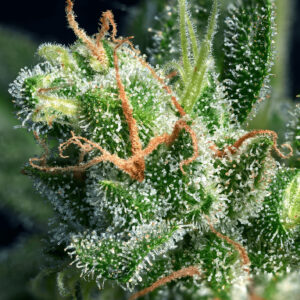The word anandamide sounds like chemistry book jargon, but its name derives from the Sanskrit word for “bliss” or “joy.” Anandamide, the “bliss molecule,” helps drive feelings of pleasure. It’s the molecule responsible for runner’s high, the sense of increased well-being and reduced stress. It’s also one of the molecules that have the same feeling as cannabis high or the euphoria after consuming marijuana.
What is Anandamide and How Does It Work in the Body?
Anandamide is a neurotransmitter and an endogenous cannabinoid, also known as an endocannabinoid. Cannabinoids are the active chemical compounds in cannabis. Endocannabinoids are similar molecules made endogenously—in other words, within the human body.
Cannabinoids interact with your endocannabinoid system (ECS), a complex network of cellular receptors and chemical signals found throughout the body.
We do know that the ECS is responsible for homeostasis in the body. It also regulates immune function, pain and reward centers, and metabolic functions, which is not surprising when you consider that cannabinoids are known to affect pain and pleasure levels and impact weight loss and weight gain.
Legal and cultural prohibitions against marijuana have hampered research into the ECS and associated molecules like anandamide, but as those restrictions lift, scientists are getting a better picture of just how important the ECS is, with upcoming studies investigating whether it could play a role in treating cancer, substance abuse and more.
Studies suggest that anandamide works with the ECS to modulate memory, motivation and appetite, sleep and emotional responses to stress, among other functions. Research also suggests that anandamide has a “hedonic impact,” meaning it can increase the pleasurability of eating and other experiences.
The Connection Between Anandamide & Cannabis
Anandamide is especially unique because it interacts with the same ECS receptors that the THC in cannabis does. This is why some folks can experience feelings of euphoria and contentment when consuming THC.
The main difference is that THC reacts with the ECS receptors after consumption. Your own body produces anandamide to interact with them.
Even though THC and anandamide bind to the same receptors, anandamide is a much more fragile molecule. After it’s produced in the brain, anandamide is quickly broken down into other compounds by an enzyme called fatty acid amide hydrolase (FAAH). The slower FAAH works, the longer anandamide stays in the body—and the longer it promotes the blissful feeling it’s named for. This chemical pathway is of major interest to scientists, who think it may lead to treatments for disorders involving the nervous system, like anxiety.
Exercise and Food May Stimulate Anandamide Levels, But Is That a Good Thing?
The best-studied way to release anandamide in your body is through exercise. Studies in this area are in the early stages. Researchers can’t say which types of exercise or how much you need to get the most considerable anandamide boost or whether folks with pain conditions like fibromyalgia will get the same endocannabinoid effects as others.
Another way to potentially stimulate anandamide production is to eat foods that either contains the molecule or inhibit FAAH, allowing the anandamide to stick around longer. Chocolate contains anandamide and two other compounds that slow down its breakdown, which in theory would allow anandamide to circulate longer in the system. Researchers found anandamide in cocoa solids, which gives dark chocolate its intense flavor. This suggests that the darker the chocolate, the higher the likelihood it contains anandamide.
Unfortunately, research on food and anandamide hasn’t reached a prescriptive level, meaning anyone knows how much chocolate, maca, or truffle a human would need to consume to stimulate an enjoyable or therapeutic level of anandamide, or if that’s even a consistently desirable outcome.
We know anandamide feels good but is also related to developing addictive behaviors. However, researchers are still figuring out how it might contribute to addiction or treat addictive disorders.






